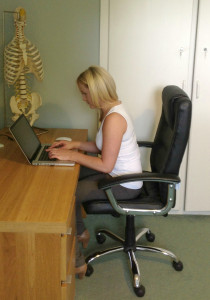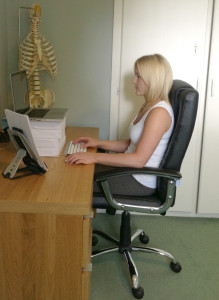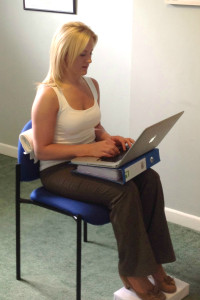Using your laptop safely to avoid neck injury – By Olivia O Leary D.C BSc ( Hons)

Unsafe: An ongoing trade off between poor neck/head posture and poor wrist/hand posture exists with Chiropractor Yvonne in this image
Laptop computers are lightweight, portable and convenient but unfortunately their design with the screen and keyboard attached forces laptop users into awkward postural positions. When the screen is positioned by the user at the right height, the keyboard position is too high and when the keyboard is at the correct height the screen is too low.
Laptops pose less risk when used for short periods but with many using the laptop as their main computer our team at here at Gorey Family Chiropractic were asked for some guidelines applicable for this type of computer user.
A COMFORTABLE WORKSTATION SETUP ON A DESKTOP COMPUTER OR LAPTOP PROMOTES NEUTRAL POSTURES AVOIDING STRAIN THEREFORE:
- the neck should be aligned with the spine (a neutral posture – not bent or thrust forward)
- the back should be relaxed but supported,
- the shoulders should be relaxed (not hunched or rounded),
- the elbows should be close to the body and bent at an angle between 90 and 120 degrees and
- the wrists and hands should straight (not bent or turned).
So If you use a laptop frequently, it is worth investing time into optimising your home or office workstation to promote better ergonomic postures for your laptop use, to avoid what research has shown is the long term inevitability of neck pain and back pain otherwise.

Safer: Using an external keyboard and mouse and raising the screen with paper reams improves this laptop workstation for Chiropractor Yvonne
SETTING YOUR LAPTOP UP FOR FREQUENT USE
Maintain a neutral neck posture by placing the top of the screen at about eye level or slightly lower if using bifocal glasses.
Use a laptop stand or place your laptop on a stable support surface, such as monitor risers, reams of paper, or phone books so that the screen height can be adjusted.
Attach a regular size, external keyboard and mouse to the laptop, and place them on an adjustable keyboard tray or desk if possible. They should be positioned at or slightly below elbow height when it is possible to use an adjustable keyboard tray.
Angle the screen to reduce bending your head forward. Use your eyes instead of your neck to adjust your line of vision.
Reduce glare by positioning the screen at a right angle to windows and away from overhead lighting. Laptop lights that plug into a USB port can be used to provide extra light, if needed.
REMEMBER TO:
- Clean the screen frequently as dust can make it difficult to read and may increase eyestrain.
- Watch for glare from external light sources on your screen which also causes eyestrain.
- Use a document holder where possible to angle documents vertically to keep the neck well aligned with the spine.
- Take frequent stretch breaks every 30 to 45 minutes.
QUICK ERGONOMIC FIXES FOR SHORT TERM LAPTOP USE
- Use a chair that supports a comfortable upright or slightly reclined posture. In a reclined position,

Safer: A binder helps keep wrists straight and optimises the screen height. Note a ream of paper improves the trunk/thigh angle. A rolled towel adds lumbar support.
prop your feet up on a box or something similar to maintain a neutral trunk/thigh angle.
- Be sure to maintain a neutral neck posture (in other words not leaning the neck forward). Use a towel roll or inflatable lumbar pillow to provide low back support.
- Place the laptop on your lap to help keep your wrists straight while using the keyboard. A 2-3 inch binder with the wider edge toward you knees will create an angle that will help keep your wrists straight and maximize the height of the screen.
- Don’t place your laptop on top of a pillow or other soft material. The lack of circulation could shut down the fan, which can overheat the computer.
- On a sofa, place a rolled towel as a lumbar support, raise the feet on a small box so that you are tilted slightly backwards to maintain straighter spinal alignment.
- Remember to stand up and stretch frequently.
GOREY FAMILY CHIROPRACTIC: SUPPORTING RECOVERY, MAINTAINING RECOVERY AND PREVENTING INJURY
Our specialist Chiropractic team are trained and hold extensive occupational health experience both in Ireland and the U.K and are specialists in the diagnosis and treatment of back pain, neck pain and other workplace related muscle and joint problems. No referral is necessary.
We have x-ray facilities located on site and offer spinal health screening programmes and ergonomics assessments to companies and organisations to prevent and manage workplace injury. For your convenience all of our Gorey Family Chiropractic team are registered with VHI, Glo, Aviva and Laya Healthcare allowing clients claim reimbursement from a wide range of private healthcare Insurance providers.
For further information on our range of services to private individuals or companies contact info@chiropractor.ie or alternatively call 053 94 83338